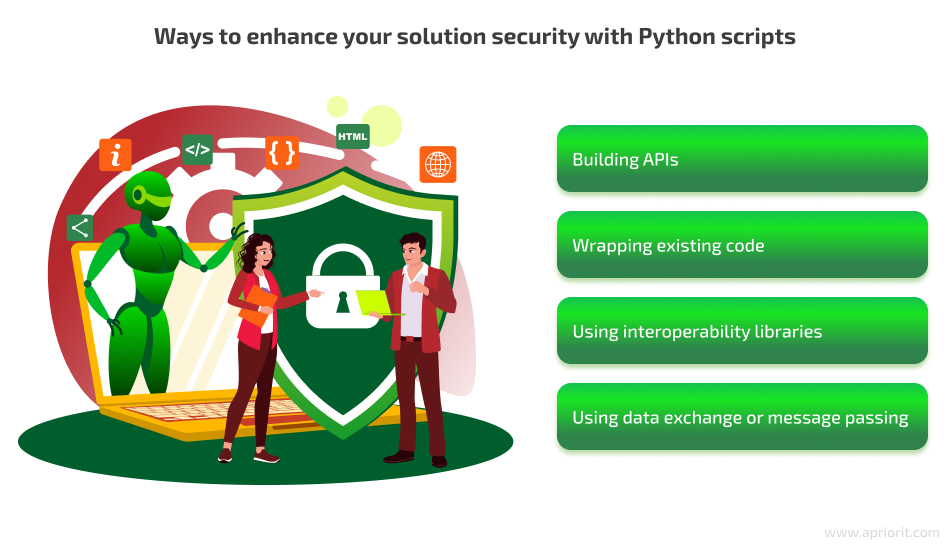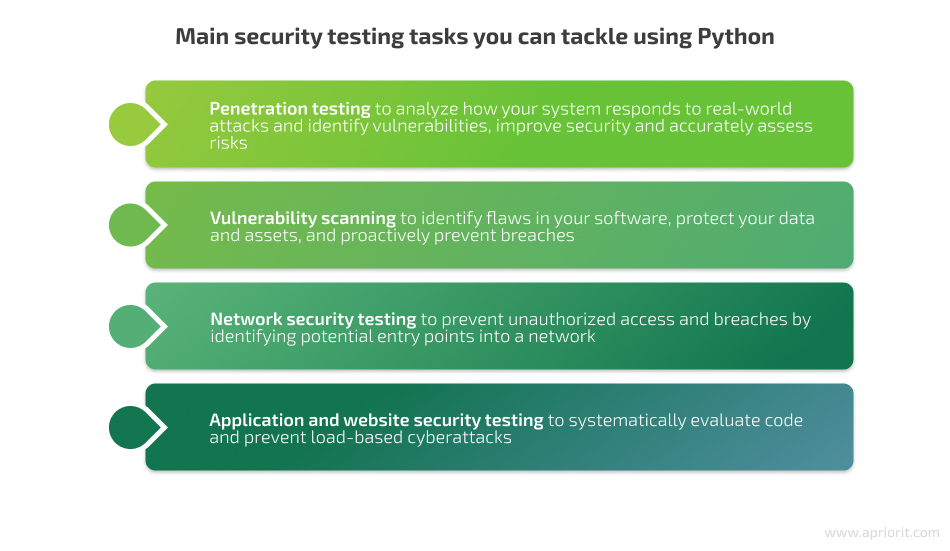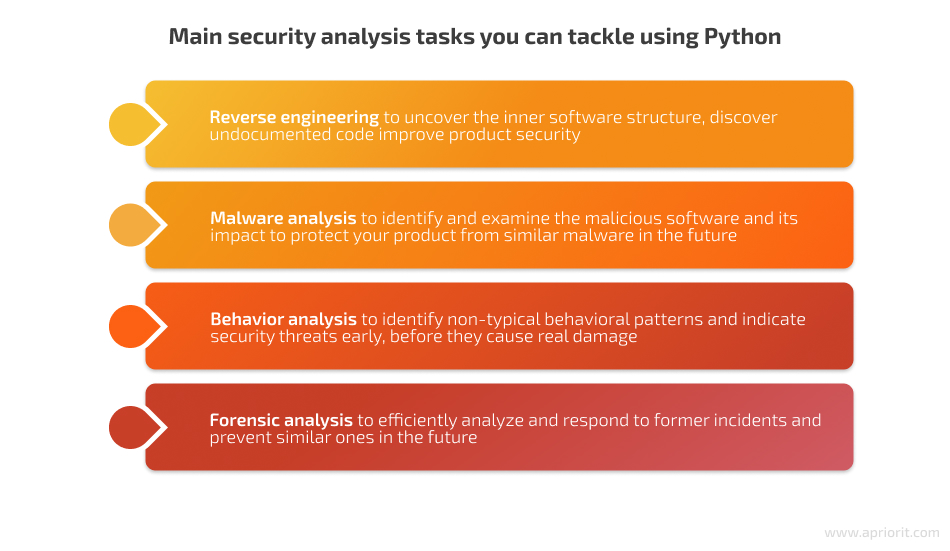Ensuring a software product’s security is challenging for most businesses. Companies are constantly searching for technology that can efficiently cover their cybersecurity needs. One option is to use Python and Python-based tools.
In this article, we share what Python tools Apriorit experts use for various cybersecurity activities. You’ll get a list of Python tools and packages that will help you protect your product, detect issues, and automate your cybersecurity efforts.
This article will be useful for product owners and CTOs who are looking for ways to protect their software and increase the efficiency of their cybersecurity strategy by automating security testing and analysis.
Contents:
All these benefits make Python a great choice for ensuring your software security. But how is Python used in cybersecurity exactly? Let’s explore.
How to use Python tools for cybersecurity
Python is a high-level, interpreted programming language known for its simplicity and readability. You can find a large pool of libraries written in Python due to its portability, fast script creation, versatility, and clean code design principles.
Automation is one of the biggest advantages that Python cybersecurity tools offer. Python allows developers to focus on complex issues, streamline cybersecurity, and increase overall software security.
Usually, developers and security specialists integrate Python cybersecurity tools into their products in the form of automated scripts. Python offers a vast number of libraries, packages, and frameworks that contain ready modules. These allow developers to create productive and fast scripts for any existing solution regardless of the core programming language. Automated scripts are the most common way of integrating Python cybersecurity tools into a software product.
If you want to enhance the security of your existing software, you can integrate Python scripts for cybersecurity with one of these techniques:

- Using interoperability libraries. Python offers various libraries that allow you to call functions or methods from existing software written in another language including C/C++, Java, and .NET. These libraries bridge the gap between languages and frameworks, binding scripts and your software together. For example, Cython allows for communication between Python and C code.
- Building APIs. Application programming interfaces (APIs) are a universal way to connect two different pieces of software and enable data exchange. To connect Python scripts to your existing software, you can use frameworks like Flask, Django REST, or FastAPI.
- Wrapping existing code. This approach entails creating a Python wrapper around your existing code and providing Python with an interface to interact with your software functions.
- Using message passing or data exchange. With this method, you create a communication channel between your code and Python scripts. For this, you can use inter-process communication or message queues through libraries like ZeroMQ. This keeps your code clear, modular, and scalable.
Script automation is integrated into most cybersecurity-related Python tools, which allows developers to customize their scripts and use minimal code to create them.
Although Python has a vast number of libraries and tools, it can be challenging to figure them out on your own. At Apriorit, we constantly use Python for cybersecurity tasks and have a toolkit of time-proven Python libraries, frameworks, packages, and tools. In the next two sections, we share some practice-based recommendations for Python tools that can help boost your product’s cybersecurity.
We’ve divided cybersecurity activities into two main categories:
- Security testing
- Security analysis
Both of these activities are essential for maintaining robust security in software products. You can find many effective Python tools that can cover these cybersecurity tasks and help you assess every part of your software. Let’s explore uses for the Python language in cybersecurity and the tools it offers for each task.
Need to protect your application’s code from hackers?
Reach out to our cybersecurity experts and get bullet-proof protection for your software!
Using Python tools for security testing
Security testing allows you to evaluate your software and identify vulnerabilities, weaknesses, and potential cybersecurity threats. During security testing, cybersecurity specialists run tests and attack simulations to determine how well software can withstand security attacks and protect sensitive data. It’s vital to conduct security testing regularly to make sure your software is secure against hacker attacks.
Here are the main cybersecurity testing tasks you can complete using Python tools:

Let’s discuss the key security testing tasks in detail and explore how Python-based tools can help you uncover and eliminate security vulnerabilities within your system.
Penetration testing
Penetration testing imitates real-world attacks and analyzes how networks, systems, and applications respond. This process allows cybersecurity specialists to assess risks, identify vulnerabilities, and provide recommendations for security improvements.
Apriorit’s penetration testing team uses Python in cybersecurity activities like payload generation and exploitation, web app testing for identifying security weaknesses, password security assessment, and packet sniffing and TCP packet injection for network analysis. These activities help to proactively identify and address security weaknesses, thus protecting the organization’s reputation.
If you are looking for penetration testing instruments, there are many Python-based libraries and tools to automate this process including:
- PyMetasploit — a library that allows penetration testers to write and automate Metasploit scripts in Python to identify vulnerabilities, execute attacks, and evade detection
- Python Nmap — a library that helps your pentesting team use the Nmap port scanner, enabling them to identify active hosts on a network and use them for penetration testing activities
- PyCrypto — a package for encryption, decryption, hashing, and key management that pentesters can use to test cryptographic implementations and analyze vulnerabilities
- Matplotlib — a data visualization and analysis tool that helps you create reports and visualize data to create an actionable plan after you’ve completed your penetration testing activities
Vulnerability scanning
Vulnerability scanning is a systematic process of searching for weaknesses and flaws in software, networks, or systems. It allows businesses to protect their data and assets, comply with regulations, and proactively prevent breaches. Often, the results of vulnerability identification are later used in penetration testing, which we will discuss in the next section.
To effectively identify vulnerabilities and leave no chance for attackers to exploit them, Apriorit’s security specialists conduct regular security audits, static analysis, code reviews, and more.
Python has many tools and libraries that can help you build automated scripts for regular vulnerability scanning, including:
- Bandit — a static code analysis tool that specifically focuses on identifying security issues and vulnerabilities in Python code, checking for potential security flaws such as SQL injection, command injection, and more
- ZAP API Python — an API that gives access to the popular ZAP web app scanner for automating security scans and identifying vulnerabilities in web applications
- Vulners — a Python library that gives you access to the world’s largest security database that allows you to analyze information about known vulnerabilities and associated exploits; it also offers APIs for search, retrieval, archiving, and vulnerability scanning
Read also
Third-Party Integrations with Python: Capabilities and Tools
Leverage Python to establish seamless integrations with third-party services and securely expand your product’s functionality and abilities.

Network security testing
The network is one of the most common entry points for hackers. Network security testing allows cybersecurity specialists to prevent unauthorized access, hacker attacks, and breaches by identifying network weaknesses and potential entry points.
Apriorit’s cybersecurity team uses Python for network security testing and automating activities like port and network scanning, socket programming, and web server fingerprinting.
Here are some Python-based libraries that can help you with these tasks:
- Scapy — a Python packet manipulation library that’s used to generate custom packets. It helps in network analysis, penetration testing, and forensic investigation, making it an incredibly universal and widely used cybersecurity tool.
- Socket — a built-in module that allows you to create and manipulate sockets. With Socket, you can create your own cybersecurity tools like network scanners and port scanners.
- Httprint — a web server fingerprinting tool that can be used with Python for identifying the web server software and version, even if it’s obfuscated.
Application and website security testing
Application and website security testing involves a systematic evaluation of software code and configurations that could be exploited by attackers. By performing regular software testing, you can protect your product from DDoS attacks and other load-based cyberattacks.
In order to assess how well a system can resist and perform under pressure, our cybersecurity team simulates high levels of traffic and stress.
Python offers a multitude of libraries that can help automate activities like load generation, stress testing, and DDoS simulation. Let’s take a look at some of them.
- Locust is an open-source tool that can test a system by swarming it with millions of simultaneous users. The Apriorit team uses Locust to identify bottlenecks, performance issues, and system limitations through load testing.
- AsyncIO is an asynchronous library our cybersecurity specialists use for app stress testing by creating scripts with multiple concurrent requests or connections.
- Psutil is a cross-platform library for process and system monitoring. It helps cybersecurity specialists monitor system resources during load testing and identify vulnerabilities or performance issues.
As you can see, by conducting security testing with different Python tools, you can enhance your system’s resilience against real-world attacks, minimize vulnerabilities, and proactively protect your assets.
Now, let’s talk about mitigating security risks using security analysis and how you can improve your product’s cybersecurity with Python tools.
Read also
How to Detect Vulnerabilities in Software When No Source Code Is Available
Find out how dynamic fuzzing can help your team detect vulnerabilities that remain undiscovered by traditional testing methods.
Using Python tools for security analysis
Security analysis allows you to proactively assess the security of your app or system, understanding its security architecture as well as its efficiency.
To protect your software against possible cybersecurity threats and malefactors, writing seemingly secure quality code isn’t enough. Depending on the task at hand and the industry you’re operating in, you might need to apply different forms of advanced security analysis:

Python offers a wide selection of tools that can help your developers and security experts accomplish all of these tasks. Keep in mind that this is in no way a complete list of Python tools for security analysis.
Reverse engineering
Reverse engineering is the process of analyzing software to uncover the inner workings and structure of both hardware and software. It’s vital for improving product security, learning about undocumented code, and ensuring compatibility with third-party tools. You can also use reverse engineering to protect your sensitive data from cyber attacks or discover intellectual property rights violations.
Reverse engineering requires developers to have deep expertise and extensive knowledge in cybersecurity. Apriorit’s reverse engineering specialists have strong technical backgrounds and are ready to solve non-trivial tasks.
At Apriorit, we use Python tools to automate the disassembly and decompilation of binary files into a readable format, thus getting a better understanding of the program’s low-level instructions. For instance, for one of our projects, Apriorit reverse engineers used Python to improve IDA’s capabilities for manipulating disassembly code. Python scripts also help extract specific information, manipulate data, or perform static and dynamic analysis.
If you’re looking for Python tools for reverse engineering activities, pay attention to the following:
- Capstone — a lightweight disassembly framework with bindings for Python that’s used by reverse engineers to disassemble machine code into human-readable assembly language
- Radare2 — a powerful command-line tool and library for reverse engineering, disassembling, debugging, and analyzing binary files
- Frida-Python — a portable set of Python bindings that allows developers to write Python scripts for dynamic analysis and debugging using the popular Frida framework
- Pyhidra — a Python library for cybersecurity that gives direct access to one of the most powerful reverse engineering tools called Ghidra, which allows you to reverse engineer binaries, debug and analyze code, as well as decompile, script, and collaborate
- Angr — an open-source Python framework for static and dynamic binary analysis that helps engineers understand the inner workings of closed-source software and identify potential vulnerabilities
Related project
Vulnerability Assessment of a Protected Environment
Explore how our in-depth cybersecurity audit helped shape a refactoring plan to remove the detected vulnerabilities in the client’s software. In the long run, the audit helped fo enhance our client’s product security.
Malware analysis
Malware analysis allows developers to identify and examine malicious software to determine its potential impact, behavior, and functionality. Python-based tools for static and dynamic malware analysis can help you identify malware characteristics and protect your software from similar malware in the future by running malware in a secure and isolated environment.
This is especially important for developing antivirus software, threat intelligence platforms, and other cybersecurity solutions, as malware can actively avoid sandboxes and try to remain undetected.
Apriorit’s cybersecurity team uses Python tools at every stage of malware analysis, from installing libraries and setting up controlled environments to emulating and executing code in them. This allows our cybersecurity specialists to observe malware behavior without any risks.
Here are the main Python tools and libraries we recommend for efficient malware analysis:
- Pyew — a Python-based command-line tool to perform forensic analysis on malware samples that can convert and disassemble files and analyze code sections in them to detect suspicious behavior
- Yara-python — a library that allows you to use YARA, a popular tool for malware research, detection, and identification
- Cuckoo Sandbox — a tool that allows you to run malware in a secure and controlled environment so you can safely analyze any suspicious file and get a detailed report on what it file does when executed
- Malgazer — an ML-based Python library for malware analysis that helps you automate various analysis tasks, extract features from malware samples, classify malware, and identify patterns and trends of various malware samples
Behavior analysis
Behavior analysis allows you to detect any unusual activity in your systems or networks, or even in user actions. Any unexpected or non-typical behavioral patterns can indicate security threats posed by malicious insiders, malware infection, DoS attacks, and more.
The Apriorit cybersecurity team analyzes behavior using Python-based tools to set up pattern recognition and anomaly detection. Python tools can also help automate real-time behavior analysis so you can quickly respond to attacks and prevent them before any damage is caused.
Here is a wide variety of Python libraries that can help you easily detect unusual behavior in your system:
- PyOD — a specialized and unified Python library with a comprehensive set of scalable algorithms for detecting unusual data in various software systems, even in large unlabeled datasets
- Scikit-learn — a popular ML-based Python library that has a wide range of algorithms for anomaly detection based on data outliers
- TensorFlow — an open-source machine learning library for detecting unusual patterns. You can simplify your work with TensorFlow using Keras, a frontend API that provides a high-level interface for building neural networks.
- Prophet — a Facebook-backed library for detecting anomalies in time series data that you can use to identify abnormal network traffic or system behavior
Read also
Anomaly Detection on Social Media: How to Build an AI-Powered SaaS Platform with Python Tools
Develop a smart anomaly detection solution. Learn who can benefit from such a solution and how to use AI and Python to create a SaaS media monitoring platform for your customers.

Forensic analysis
Forensic analysis allows you to efficiently respond to cybersecurity attacks, recover damaged data, and prevent similar incidents in the future by protecting your software.
Apriorit’s cybersecurity team uses Python tools to conduct forensic analysis with the help of data carving, log analysis, and other activities.
Here are the most popular libraries that you can use for forensic analysis:
- Dfvfs — a library that provides read-only access to filesystem objects from various types of storage media and file formats
- Volatility — an advanced memory extraction framework that helps to identify running processes, network connections, and open files, or detect signs of malware or intrusions
- Rekall — a popular framework that provides advanced memory analysis capabilities
Before you can analyze data, you need to retrieve it. Data extraction allows you to get data from all kinds of sources including files, databases, servers, network traffic, and logs. For this, you can use libraries like BeautifulSoup, MechanicalSoup, and Requests.
Overall, security analysis isn’t just a set of tasks you need to execute. It is a process you need to conduct continually to prevent attacks and respond to them fast. The right security analysis strategy, paired with the power of Python tools and automation, can make your cybersecurity efforts more efficient and consistent.
Conclusion
Ensuring a product’s cybersecurity requires a complex approach that includes regular testing, analysis, patching, and bug fixing. Cybersecurity automation with Python scripts can help you conduct regular security activities and cover each part of your software so it doesn’t become an entry point for hackers.
Each cybersecurity activity we’ve mentioned in this article is a high-level concept that includes many different steps and tasks. To tackle them effectively — and with the use of the most fitting tools and approaches — you can delegate your software’s development and testing to Apriorit. If you need to make your solution bulletproof, our cybersecurity specialists are here to help.
Looking for expert Python developers?
Tap into our extensive experience in Python development to bolster your product’s capabilities and gain a competitive edge!


